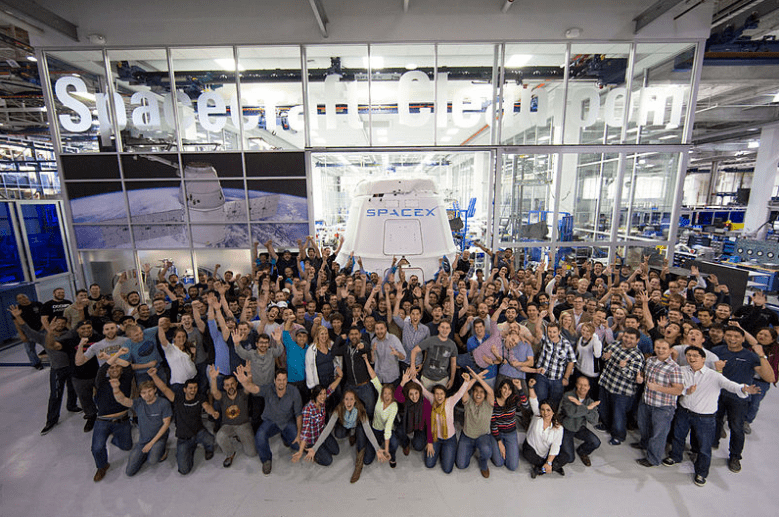The Role of the International Space Station in Scientific Research
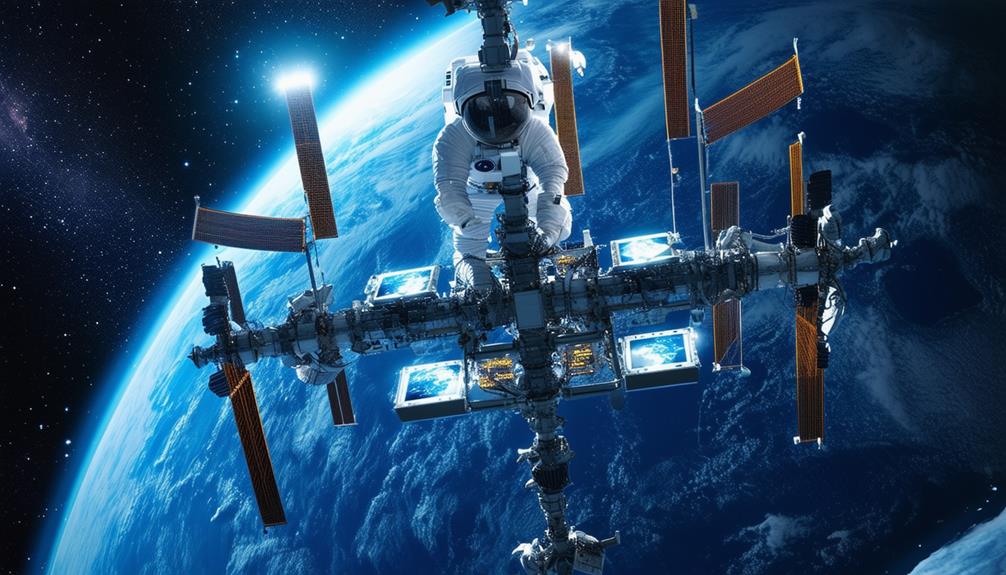
The International Space Station (ISS) is pivotal in scientific research, providing a unique environment where the effects of gravity are nearly eliminated. This enables scientists to conduct experiments that are impossible on Earth, offering unparalleled opportunities in fields such as microbiology, human health, and materials science.
The ISS also plays a crucial role in Earth observation, enhancing our understanding of climate change. With its state-of-the-art facilities and international collaboration, the potential for groundbreaking discoveries is immense. How does this orbiting laboratory drive innovations in technology and human health?
Benefits for Humanity 2022
In 2022, the International Space Station (ISS) showcased numerous discoveries and technologies that directly benefit humanity and future space exploration. The ISS's unique environment fosters groundbreaking scientific research, particularly through the study of microgravity. This enables scientists to investigate phenomena impossible to replicate on Earth, with significant implications for human health, such as understanding disease formation, testing new drugs, and examining the inner workings of the human body.
Additionally, the ISS serves as an invaluable center for technological innovation. Advanced robots and computers developed aboard the station are crucial for space exploration and have practical applications on Earth. The ISS also contributes significantly to climate change research and natural disaster monitoring, with over 3.5 million Earth photographs aiding these efforts. Furthermore, experiments on DNA sequencing and genome editing in microgravity open new avenues for potential applications, including mining metals on other planets.
Unique Research Opportunities
The International Space Station offers unparalleled research opportunities in a microgravity environment that can't be replicated on Earth. Equipped with advanced scientific facilities and extended mission durations, the ISS enables groundbreaking investigations in life sciences, physical sciences, and technology. These unique opportunities are crucial for advancing our understanding and capabilities in space exploration.
Microgravity Research Benefits
Utilizing the unique microgravity environment of the International Space Station (ISS), researchers are uncovering groundbreaking insights into microbial behavior and human health that are unattainable on Earth.
For instance, microbes exhibit different behaviors in space, facilitating the development of new genome editing tools and DNA sequencing methods. These advancements contribute significantly to our understanding of human health.
Protein crystals grown in microgravity are more structured and larger than their Earth-grown counterparts, enabling researchers to examine disease mechanisms with greater precision and develop more effective drugs.
Additionally, tissue chips—small devices that mimic the structure and function of human organs—are employed on the ISS to simulate diseases and test treatments in ways that Earth's gravity doesn't permit.
Advanced Scientific Facilities
The International Space Station (ISS) features a range of specialized modules and cutting-edge facilities that present unmatched opportunities for scientific research in microgravity. Among the advanced equipment on board are the BioServe Culture Apparatus and the Hand Grip Dynamometer, which facilitate diverse scientific experiments across multiple disciplines.
A standout laboratory on the ISS is Kibo, the Japanese Experiment Module. Kibo not only supports essential scientific research but also enables commercial projects. This module exemplifies the collaborative efforts of international space agencies such as NASA, ESA, and JAXA, conducting a wide array of experiments in fields like biology and physics.
Additionally, the ISS houses state-of-the-art facilities such as the Fluid Physics Experiment Facility (FPEF) and the Protein Crystal Growth Facility (PCRF). These specialized laboratories allow researchers to explore fluid dynamics and protein crystallization in ways that aren't possible on Earth.
Whether focused on fundamental science or applied research, the ISS provides a unique platform that leverages the advantages of microgravity to expand the frontiers of scientific knowledge.
Earth Observation and Climate
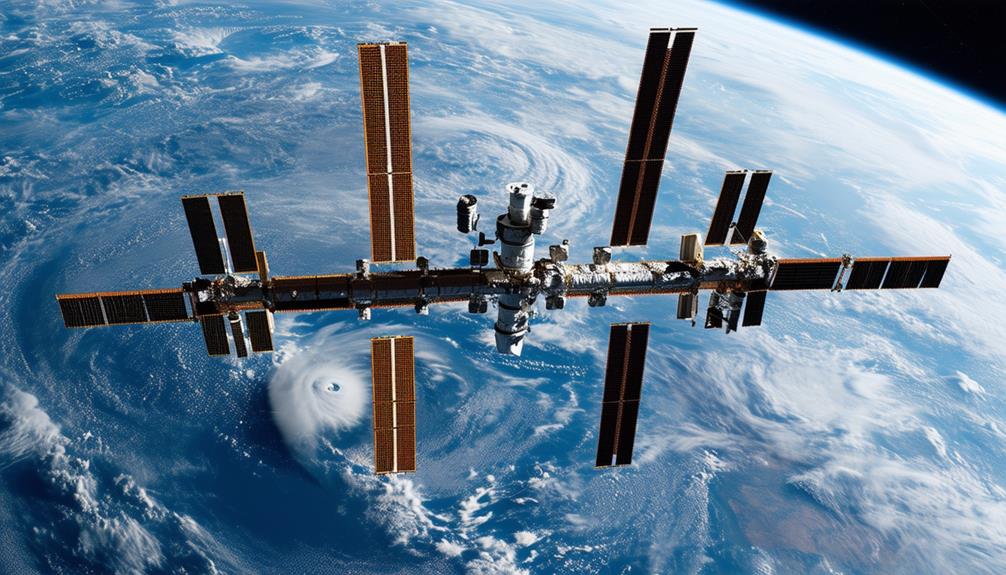
With over 3.5 million photographs of Earth, the International Space Station (ISS) significantly contributes to research on atmospheric phenomena, climate change, and natural disasters. The ISS's unique vantage point facilitates Earth observation, aiding scientists in monitoring and comprehending our planet's dynamic systems. By capturing data on atmospheric changes, the ISS enhances environmental monitoring and provides crucial insights into the ongoing shifts due to climate change.
The ISS is instrumental in tracking natural disasters, offering real-time data essential for effective disaster response efforts. It also plays a pivotal role in evaluating light pollution, which affects both human health and wildlife. The imagery and data collected improve global understanding of the complex interactions within our atmosphere.
Key visualizations provided by the ISS include:
- Massive hurricanes swirling in the ocean, enabling early warning systems to save lives.
- Melting ice caps and glaciers, offering tangible evidence of climate change.
- Widespread forest fires, aiding in the coordination of firefighting efforts.
- Urban areas illuminated at night, revealing patterns of light pollution.
- Volcanic eruptions and ash plumes, impacting aviation and local communities.
These visualizations and data sets are crucial for scientists, policymakers, and emergency responders, bolstering efforts to mitigate the effects of climate change and improve disaster preparedness and response.
Microbiology Studies in Space
The International Space Station (ISS) provides a unique environment to study how microbes behave in microgravity. Advances in DNA sequencing and genome editing tools enable researchers to understand microbial changes in this setting. These investigations not only reveal how microbes adapt to space conditions but also suggest future applications, such as bio-mining on other planets.
Microbial Behavior in Microgravity
Microgravity on the ISS reveals intriguing changes in microbial behavior, spurring groundbreaking research using DNA sequencing and genome editing tools. When studying microbes in space, they exhibit different behaviors compared to Earth. These microgravity studies are crucial for understanding microbial adaptation to space conditions. Advanced DNA sequencing and genome editing allow for the identification of specific genetic and behavioral changes.
Experiments on the ISS provide a controlled environment, ideal for isolating variables and observing microbial responses. The findings from these studies extend beyond space exploration, offering applications on Earth, such as enhancing health and safety standards.
Consider the potential outcomes:
- Microbes adapting to microgravity, potentially increasing antibiotic resistance.
- Altered biofilm production by bacteria, affecting material and equipment integrity.
- Development of new methods for mining metals on other planets based on microbial efficiency.
- Advanced bioremediation techniques inspired by space research.
- Innovative drug discovery processes informed by microbial adaptations in space.
DNA Sequencing Advances
Advanced DNA sequencing tools aboard the ISS are revolutionizing our understanding of microbial behavior in space. By studying microbes in microgravity environments, researchers gain valuable insights into how space conditions impact their growth and behavior. DNA sequencing and genome editing technologies facilitate deeper investigations into microbial responses and adaptations, revealing potential risks and benefits for long-term space missions.
Microbiology studies on the ISS extend beyond understanding microbial behavior; they're also driving scientific breakthroughs. The sanitized and confined environment of the ISS offers a unique setting to examine how microbes grow and evolve under space conditions, leading to improved strategies for maintaining astronaut health and safety.
Moreover, this research has practical applications beyond Earth. Advanced microbiology research on the ISS explores how microbes could be utilized for extracting metals on other planets. By understanding how these organisms behave and adapt in space, scientists can harness their capabilities for in-situ resource utilization, making future space missions more sustainable and efficient.
Innovations in Human Health
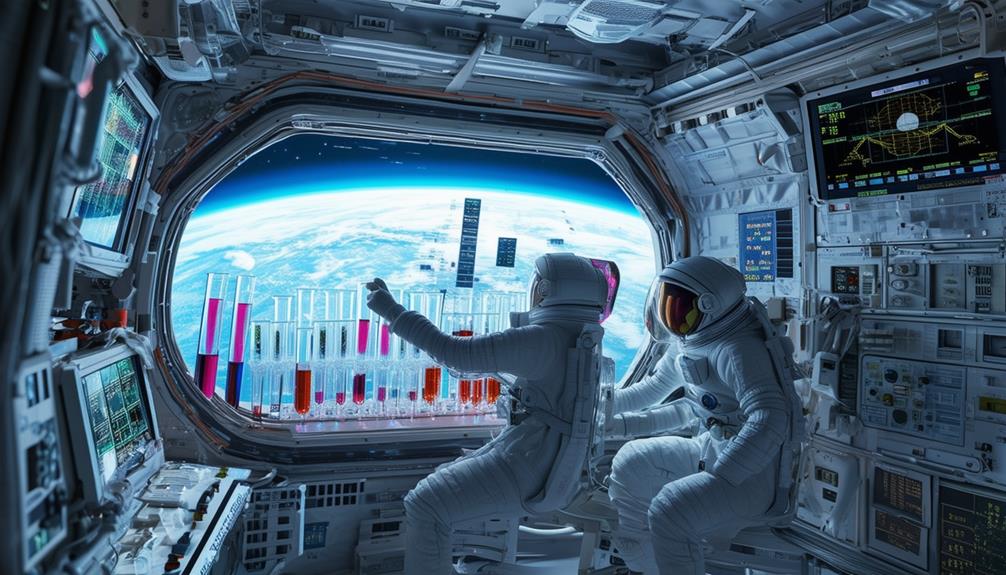
The International Space Station (ISS) is revolutionizing human health research by offering unique conditions to study diseases and develop new medical treatments. The microgravity environment of the ISS facilitates life science investigations that are unfeasible on Earth. For example, protein crystal growth experiments conducted on the ISS have significantly advanced drug development, providing new insights into diseases such as Alzheimer's and Parkinson's.
Human research on the ISS examines how the body reacts to space, focusing on immune system changes and the behavior of cancer cells. These studies are crucial for developing potential treatments and improving health outcomes. Advanced health monitors and tissue chips are also tested on the ISS, offering unprecedented clarity into the body's inner workings.
Consider the following advancements made possible by ISS research:
- Protein Crystals: Forming perfectly, aiding drug research.
- Cancer Cells: Exhibiting different behaviors, revealing new treatment pathways.
- Immune System: Changes that could lead to better vaccines.
- Tissue Chips: Mimicking human organs, enabling safer drug tests.
- Health Monitors: Providing real-time data, enhancing medical care.
These innovations highlight the ISS's pivotal role in transforming human health research, offering promising avenues for medical advancements.
Technological Advancements
Experiments aboard the International Space Station (ISS) are driving the development of groundbreaking technologies across various industries. By conducting technology demonstrations in microgravity, researchers can test and refine innovations that are challenging to develop on Earth.
For instance, advancements in 3D printing are enabling the manufacturing of complex parts directly in space, which is crucial for future missions. Additionally, alloy development experiments are producing stronger, lighter materials for aerospace and automotive applications.
Collaborations with private companies on the ISS are enhancing material properties, paving the way for in-space construction and repair. This capability could revolutionize long-term space exploration by allowing the building of structures and the repair of satellites without the need to return to Earth.
Solar energy generation is another key focus. Testing different solar panels for efficiency and durability in the harsh space environment helps develop more effective renewable energy sources. These insights contribute to sustainable energy solutions for both spacecraft and potentially for Earth.
Ultimately, the ISS serves as a hub for technological advancement, driving innovations that impact everything from space travel to everyday life on Earth. By leveraging its unique environment, researchers are pushing the boundaries of what's achievable.
Water Purification Systems
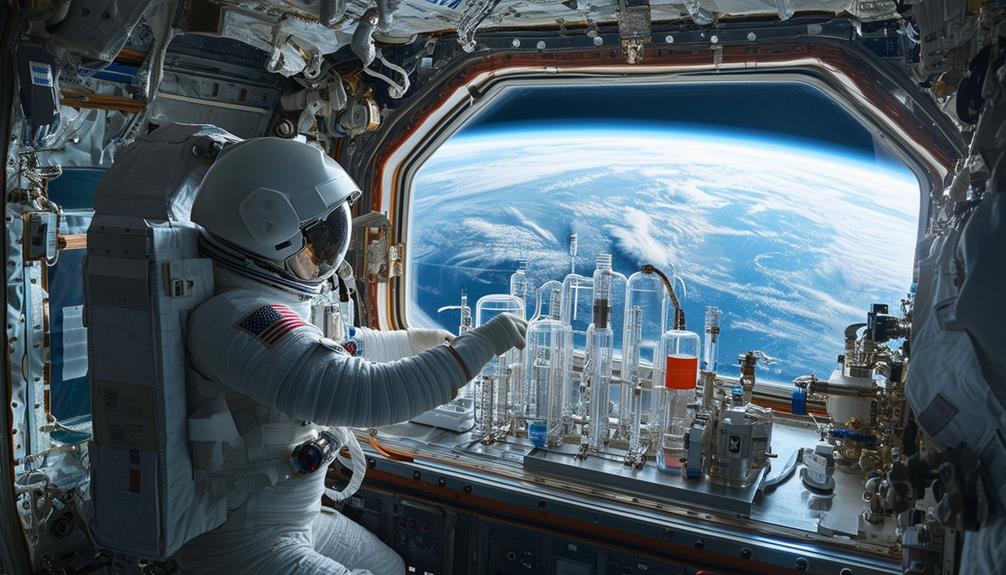
Water purification systems aboard the International Space Station (ISS) showcase how space research benefits life on Earth while ensuring the sustainability of long-duration missions. The ISS's Water Recovery System recycles 93% of the water used, essential for life support in space. This advanced system ensures astronauts have a reliable supply of clean water, crucial for their survival.
Research conducted on the ISS has significantly contributed to clean water solutions on Earth, making a real difference in communities facing water scarcity. The innovative water systems tested and refined on the ISS have led to enhancements in ground-based water filtration technologies. This cutting-edge technology exemplifies the successful transfer of space station experiments to practical applications on our planet.
Key contributions include:
- Recycling 93% of water used in space
- Adapting NASA's water treatment technologies for Earth
- Enhancing ground-based filtration systems
- Testing advanced purification systems on the ISS
- Ensuring the sustainability of life support systems in space
Through these efforts, the ISS continues to push the boundaries of what's possible, providing immediate benefits to astronauts and lasting impacts on Earth.
Space Agriculture
Space agriculture on the International Space Station (ISS) involves cultivating food in microgravity to ensure astronauts have fresh, nutritious options on long-duration missions. This research is crucial for sustainable food production and the success of future space endeavors. By studying plant growth in microgravity, we can ensure crops thrive in space and provide essential nutrients for astronauts.
Projects like Veggie and the Advanced Plant Habitat are pivotal in this effort. The Veggie project has enabled astronauts to successfully grow and consume crops such as lettuce, radishes, and zinnias, offering not only fresh food but also boosting morale.
The Advanced Plant Habitat, a more sophisticated growth chamber, allows for precise control over environmental variables, optimizing plant growth and studying plant responses to space conditions.
Through space agriculture, we're contributing to a future where astronauts can rely on in-situ resources during missions. This research is paving the way for long-term human presence on Mars and beyond. The findings from these experiments won't only support future space missions but could also revolutionize agricultural practices on Earth, making global food production more sustainable.
Materials Science and Manufacturing
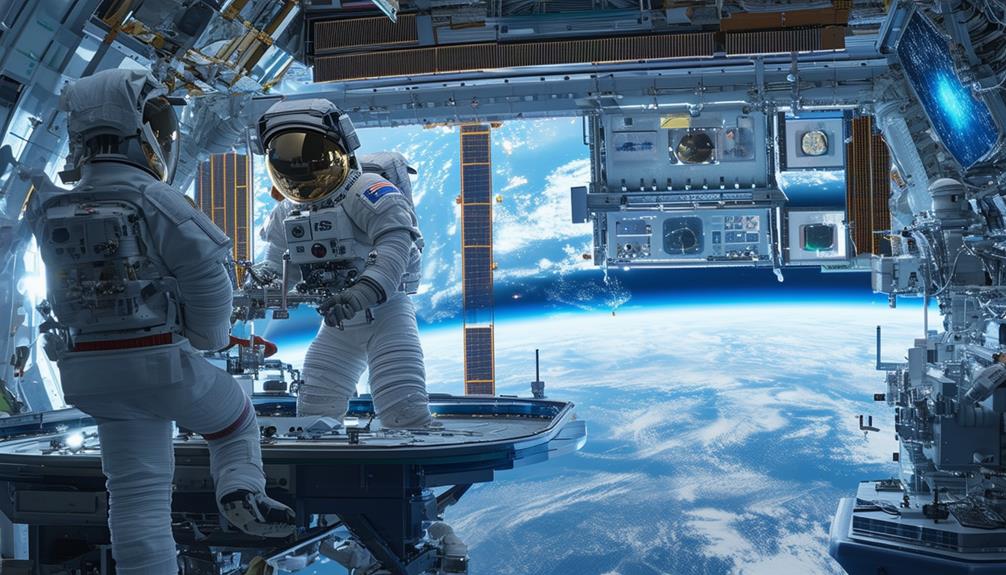
Space agriculture focuses on sustainable food production, while materials science and manufacturing on the International Space Station (ISS) aim to enhance material properties and explore advanced manufacturing processes that benefit both space missions and terrestrial industries.
On the ISS, researchers study how microgravity influences materials, leading to breakthroughs in material development and alloy innovation. This unique environment provides insights that are unattainable on Earth.
3D printing technology on the ISS is transformative, enabling the on-demand production of tools and parts essential for long-duration space missions. Experiments in space technology and in-space construction are paving the way for future habitats on the Moon and Mars. The ISS collaborates with private companies to develop innovative materials that can withstand extreme conditions, benefiting sectors like aerospace and automotive.
Key activities on the ISS related to materials science include:
- 3D printing of tools and spare parts
- Developing stronger, more durable alloys
- Testing the durability of novel materials
- Exploring the potential for in-space construction
- Collaborating with private companies on material innovation
These advancements not only support space exploration but also have significant applications on Earth.
Disaster Response and Monitoring
The International Space Station (ISS) plays a crucial role in disaster response and monitoring. From its unique vantage point, the ISS captures high-resolution images and gathers essential data to track natural disasters and climate changes. This space-based support enhances global disaster relief efforts and deepens our understanding of environmental shifts, ensuring timely and effective responses to crises.
Earth Observation Benefits
The International Space Station (ISS), with its unique vantage point, plays a crucial role in monitoring natural disasters and advancing climate change research. Positioned in orbit, the ISS facilitates Earth observation, capturing vital data that enhances our global understanding of environmental changes. This capability is essential for effective disaster response and monitoring, offering real-time insights into events such as hurricanes, floods, and wildfires.
The ISS also contributes significantly to climate change research by tracking long-term atmospheric and surface changes on Earth. These efforts are supported by international collaboration, with multiple countries participating in and benefiting from the ISS's data collection. Onboard crew members use handheld cameras to capture detailed imagery, providing a unique perspective that complements ground-based systems.
Key benefits of Earth observation from the ISS include:
- High-resolution imagery: Detailed photos of disaster zones.
- Real-time data: Immediate information during crises.
- Long-term monitoring: Tracking climate change over extended periods.
- Global coverage: Observing areas that are difficult to monitor from the ground.
- International collaboration: Sharing data to enhance global disaster response.
Through these capabilities, the ISS serves as a vital tool for improving our understanding and response to environmental challenges.
Space-Based Disaster Support
The International Space Station (ISS) offers unmatched support for disaster response and monitoring through its advanced imaging and data collection capabilities. Positioned uniquely in space, the ISS can capture critical information that ground-based systems can't when natural disasters occur. Astronauts contribute significantly by using handheld cameras to take detailed photos of affected areas, aiding emergency teams on Earth in assessing damage more accurately and deploying resources efficiently.
In addition to imagery, the ISS gathers essential environmental data through its sensors and instruments, providing insights into the extent and impact of natural disasters. This data enhances global understanding of environmental changes and supports disaster relief efforts by delivering timely and accurate information.
Furthermore, the ISS promotes international collaboration in disaster response. Countries worldwide share data and resources, working together to mitigate the effects of hurricanes, earthquakes, floods, and other natural disasters. This cooperative approach ensures optimized benefits of space-based disaster support, leading to more coordinated and effective disaster relief operations.
Conclusion
The International Space Station (ISS) revolutionizes scientific research by providing unique opportunities in fields such as microbiology, human health, and materials science—experiments that can't be conducted on Earth.
By fostering international collaboration and innovation, the ISS significantly contributes to space exploration and practical applications on our planet. Its capabilities in climate monitoring and disaster response make it a vital platform for driving advancements that benefit humanity in numerous ways.

